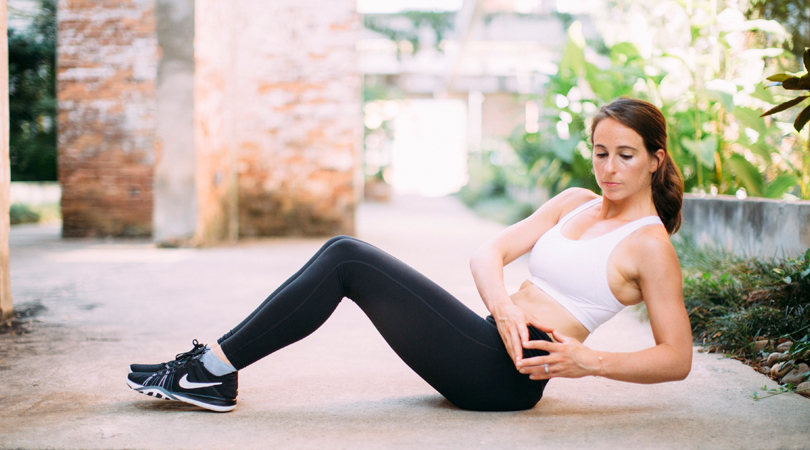
16 Jan Five Things I Wish I Knew About My Abs After Baby
Your body will never be the same. Having a baby destroys your body.
I heard these comments a few times during my pregnancy. But honestly, I ignored them. Surely this wouldn’t be the case with me. I maintained a healthy, active pregnancy—jogging through the first two trimesters, and walking until the end. I was certain I would have no problem jumping back into my old workout routine after delivery.
But it wasn’t so easy. Recovering from delivery and taking care of a brand new baby was hard. I figured I just needed more time. Although I quickly returned to my pre-baby weight (yeah breastfeeding!) my stomach pooched out like I was still pregnant. And I couldn’t work out the way I wanted to because of my weak core. I had trouble doing simple exercises like push ups—and any sort of crunch was totally out of the question. Even getting out of bed was hard. I simply could not connect to my core the way I used to.
So I started looking online for answers. Was it normal to feel this weak several months after delivery? Was it normal for my tummy to pooch out so much?
I soon found the answer. I was suffering from a common postpartum condition: “diastasis recti.” Diastasis recti is the term for abdominal separation that often occurs during pregnancy. It happens when the tissue that connects the abdominal muscles tears in half to accommodate a growing baby. Although very few women talk about it, over 60% of postpartum women experience diastasis recti! Many women silently accept that diastasis recti and a weak midsection is their new normal after baby.
Although I was thrilled to have an answer, I soon became frustrated with the conflicting information about the condition. If one resource said to do planks to heal diastasis recti, the next resource would say to NEVER do planks.
Not knowing what information to trust, I felt paralyzed—worried that if I took the wrong advice I could actually make my separation WORSE and may never heal. I was left feeling even more confused than before.
Finally, I decided to seek out the help of a physical therapist. Balancing a full time job and being a new mom was hard enough, so it was a big decision to dedicate several hours a week to take care of myself. I felt conflicted—was it selfish to take this time away from my family just for me?
As I write this now, almost a year later, I can say I am so glad that I took the time to commit to a program and heal my abs after baby. My goal was to get back into my favorite workout routines without damaging my core. Now, not only am I healed, but I honestly feel stronger than ever!
I hope other moms can learn from my story. Although it is common to have diastasis recti after baby, it does not mean you will have weak abs and a mummy tummy forever! Wherever you are on your postpartum journey—six days or six years—you CAN have strong, healthy abs after baby. If I can do it, I know you can, too!
Here are five things I learned from my diastasis recti journey:
1) Think of it as a sprained ankle—If LeBron James sprained his ankle, would doctors tell him he will limp for the rest of his life? Of course not! So why do moms feel like we will have a mummy tummy and stomach pooch for the rest of our lives? Just like a sprained ankle, there are exercises for a diastasis that make you stronger and promote healing. It is a slow process but you can rehab your diastasis recti just as you would a sprained ankle.
2) Find Other Moms—I felt like I was the only one in the world with diastasis! I didn’t know anyone who had healed their abs after baby, so I felt very isolated and hopeless. However, once I started my journey to heal, I started meeting moms with diastasis recti everywhere—at the park, school, work. Now I have a whole community of moms that support each other on their journey to get strong and healthy after baby.
3) Find a resource you trust and commit—There is a lot of information out there for moms after baby. All this conflicting information led me to feel paralyzed and kept me from taking action for several weeks. Do your research and find a program or therapist that is right for you. Then commit to it.
4) You don’t need crunches for flat abs—Before I learned about diastasis recti, I thought the path to flat abs was through crunches. The more the better! However, I have since learned this is not the case! Crunching increases intra-abdominal pressure—stressing the tissue connecting your abdominal muscles. In fact, this stress can actually make abdominal separation WORSE! There are so many abdominal exercises that strengthen your deep abdominal muscles and promote a healthier core. In fact, I don’t even do crunches anymore!
5) Taking time for yourself is good for your family—I truly believe that bringing my healthiest, happiest self to my family is the best thing I can do. If that means taking time away from them to better myself, I consider it not only an investment in me, but an investment in a stronger, healthier family. I felt a lot of guilt about taking time away from my baby to go to physical therapy. But looking back, I know I am stronger and more confident than every before—traits I want my son to develop in himself!
About the Author:
Monica is a mother to two boys. She helps mums heal abdominal separation known as diastasis recti at abs-after-baby.com. Her mission is for all mums to love their body after baby just as much–or more than before!
Instagram: https://www.instagram.com/abs_after_baby/
Facebook: https://www.facebook.com/yourabsafterbaby/
Website: http://abs-after-baby.com/


